
Trafikle ilgili anahtar kelimelere genel bakış. Burada henüz bilmediğiniz anahtar kelimeleri ve tanımları kolayca arayabilirsiniz.
More subjects
Tarsiers (/ˈtɑːrsiərz/ TAR-see-ərz) are haplorhine primates of the family Tarsiidae, which is itself the lone extant family within the infraorder Tarsiiformes. Although the group was once more widespread, all of its species living today are found in Maritime Southeast Asia, specifically the Philippines, Malaysia, Indonesia, and Brunei. They are found primarily in forested habitats, especially forests that have liana, since the vine gives tarsiers vertical support when climbing trees. Tarsiers are small animals with enormous eyes; each eyeball is approximately 16 millimetres (0.63 in) in diameter and is as large as, or in some cases larger than, its entire brain. The unique cranial anatomy of the tarsier results from the need to balance their large eyes and heavy head so they are able to wait silently for nutritious prey. Tarsiers have a strong auditory sense, and their auditory cortex is distinct. Tarsiers also have long hind limbs, owing mostly to the elongated tarsus bones of the feet, from which the animals get their name. The combination of their elongated tarsi and fused tibiofibulae makes them morphologically specialized for vertical clinging and leaping. The head and body range from 10 to 15 cm in length, but the hind limbs are about twice this long (including the feet), and they also have a slender tail from 20 to 25 cm long. Their fingers are also elongated, with the third finger being about the same length as the upper arm. Most of the digits have nails, but the second and third toes of the hind feet bear claws instead, which are used for grooming. Tarsiers have soft, velvety fur, which is generally buff, beige, or ochre in color. Tarsiers morphology allows for them to move their heads 180 degrees in either direction, allowing for them to see 360 degrees around them. (Source: Wikipedia.org, CC BY-SA)
The Tasmanian devil (Sarcophilus harrisii) (palawa kani: purinina) is a carnivorous marsupial of the family Dasyuridae. Until recently, it was only found on the island state of Tasmania, but it has been reintroduced to New South Wales in mainland Australia, with a small breeding population. The size of a small dog, the Tasmanian devil became the largest carnivorous marsupial in the world, following the extinction of the thylacine in 1936. It is related to quolls, and distantly related to the thylacine. It is characterised by its stocky and muscular build, black fur, pungent odour, extremely loud and disturbing screech, keen sense of smell, and ferocity when feeding. The Tasmanian devil's large head and neck allow it to generate among the strongest bites per unit body mass of any extant predatory land mammal. It hunts prey and scavenges on carrion. The Tasmanian devil is the largest surviving carnivorous marsupial. It has a squat, thick build, with a large head and a tail which is about half its body length. Unusually for a marsupial, its forelegs are slightly longer than its hind legs, and devils can run up to 13 km/h (8.1 mph) for short distances. (Source: Wikipedia.org, CC BY-SA)
The tiger (Panthera tigris) is the largest living cat species and a member of the genus Panthera. It is most recognisable for its dark vertical stripes on orange fur with a white underside. An apex predator, it primarily preys on ungulates, such as deer and wild boar. It is territorial and generally a solitary but social predator, requiring large contiguous areas of habitat to support its requirements for prey and rearing of its offspring. Tiger cubs stay with their mother for about two years and then become independent, leaving their mother's home range to establish their own. The tiger has a muscular body with strong forelimbs, a large head and a tail that is about half the length of its body. Its pelage colouration varies between shades of orange with a white underside and distinctive vertical black stripes; the patterns of which are unique in each individual. Stripes are likely advantageous for camouflage in vegetation such as long grass with strong vertical patterns of light and shade. The tiger is one of only a few striped cat species; it is not known why spotted patterns and rosettes are the more common camouflage pattern among felids. The orange colour may also aid in camouflage as the tiger's prey are dichromats, and thus may perceive the cat as green and blended in with the vegetation. (Source: Wikipedia.org, CC BY-SA)
Damaliscus lunatus jimela is a subspecies of topi, and is usually just called a topi. It is a highly social and fast type of antelope found in the savannas, semi-deserts, and floodplains of sub-Saharan Africa. The hair colour of the pelage may vary across the different geographic subpopulations, being darker or lighter. This subspecies has horns with a shape that gives the effect of the space between them having a lyrate profile when seen from a certain angle, as opposed to lunate, which is seen in the sassaby subspecies found to the south: D. lunatus lunatus and D. lunatus superstes. It is in principal indistinguishable from D. lunatus topi, the topi population found to the east along the coasts. A hartebeest also has lyrate horns, but these are sharper angled. (Source: Wikipedia.org, CC BY-SA)
Tree-kangaroos are marsupials of the genus Dendrolagus, adapted for arboreal locomotion. They inhabit the tropical rainforests of New Guinea and far northeastern Queensland, along with some of the islands in the region. All tree-kangaroos are considered threatened due to hunting and habitat destruction. They are the only true arboreal macropods. Tree-kangaroos have several adaptations to an arboreal life-style. Compared to terrestrial kangaroos, tree-kangaroos have longer and broader hind feet with longer, curved nails. They also have a sponge-like grip on their paws and soles of their feet. Tree-kangaroos have a much larger and pendulous tail than terrestrial kangaroos, giving them enhanced balance while moving about the trees. Locomotion on the ground is by hopping, as with true kangaroos. Like terrestrial kangaroos, tree-kangaroos do not sweat to cool their bodies, rather, they lick their forearms and allow the moisture to evaporate in an adaptive form of behavioural thermoregulation. (Source: Wikipedia.org, CC BY-SA)
Tuatara (Sphenodon punctatus) are reptiles endemic to New Zealand. Despite their close resemblance to lizards, they are part of a distinct lineage, the order Rhynchocephalia. The name tuatara is derived from the Māori language and means 'peaks on the back'. The single extant species of tuatara is the only surviving member of its order. Rhynchocephalians originated during the Triassic (~250 million years ago), reached worldwide distribution and peak diversity during the Jurassic and, with the exception of tuatara, were extinct by 60 million years ago. Their closest living relatives are squamates (lizards and snakes). For this reason, tuatara are of interest in the study of the evolution of lizards and snakes, and for the reconstruction of the appearance and habits of the earliest diapsids, a group of amniote tetrapods that also includes dinosaurs (including birds) and crocodilians. Tuatara are greenish brown and grey, and measure up to 80 cm (31 in) from head to tail-tip and weigh up to 1.3 kg (2.9 lb) with a spiny crest along the back, especially pronounced in males. They have two rows of teeth in the upper jaw overlapping one row on the lower jaw, which is unique among living species. They are able to hear, although no external ear is present, and have unique features in their skeleton, some of them apparently evolutionarily retained from fish. (Source: Wikipedia.org, CC BY-SA)
Uakari (UK: /wəˈkɑːri/, US: /wɑː-/) is the common name for the New World monkeys of the genus Cacajao. Both the English and scientific names are believed to have originated from indigenous languages. The uakaris are unusual among New World monkeys in that the tail length (15–18 cm) is substantially less than their head and body length (40–45 cm). Their bodies are covered with long, loose hair but their heads are bald. They have almost no subcutaneous fat, so their bald faces appear almost skull-like. Like their closest relatives the saki monkeys, they have projecting lower incisors. These monkeys have the most striking red facial skin of any primate. Females choose their mates based on how red the male's face is. Evidence suggests that the red facial coloration reflects the health of the primate. (Source: Wikipedia.org, CC BY-SA)
Vampire bats, species of the subfamily Desmodontinae, are leaf-nosed bats found in Central and South America. Their food source is blood of other animals, a dietary trait called hematophagy. Three extant bat species feed solely on blood: the common vampire bat (Desmodus rotundus), the hairy-legged vampire bat (Diphylla ecaudata), and the white-winged vampire bat (Diaemus youngi). All three species are native to the Americas, ranging from Mexico to Brazil, Chile, Uruguay and Argentina. Vampire bats tend to live in colonies in almost completely dark places, such as caves, old wells, hollow trees, and buildings. They range in Central to South America and live in arid to humid, tropical and subtropical areas. Vampire bat colony numbers can range from single digits to hundreds in roosting sites. The basic social structure of roosting bats is made of female groups and their offspring, a few adult males, known as 'resident males', and a separate group of males, known as 'nonresident males'. In hairy-legged vampire bats, the hierarchical segregation of nonresident males appears less strict than in common vampire bats. Nonresident males are accepted into the harems when the ambient temperature lowers. This behavior suggests social thermoregulation. (Source: Wikipedia.org, CC BY-SA)
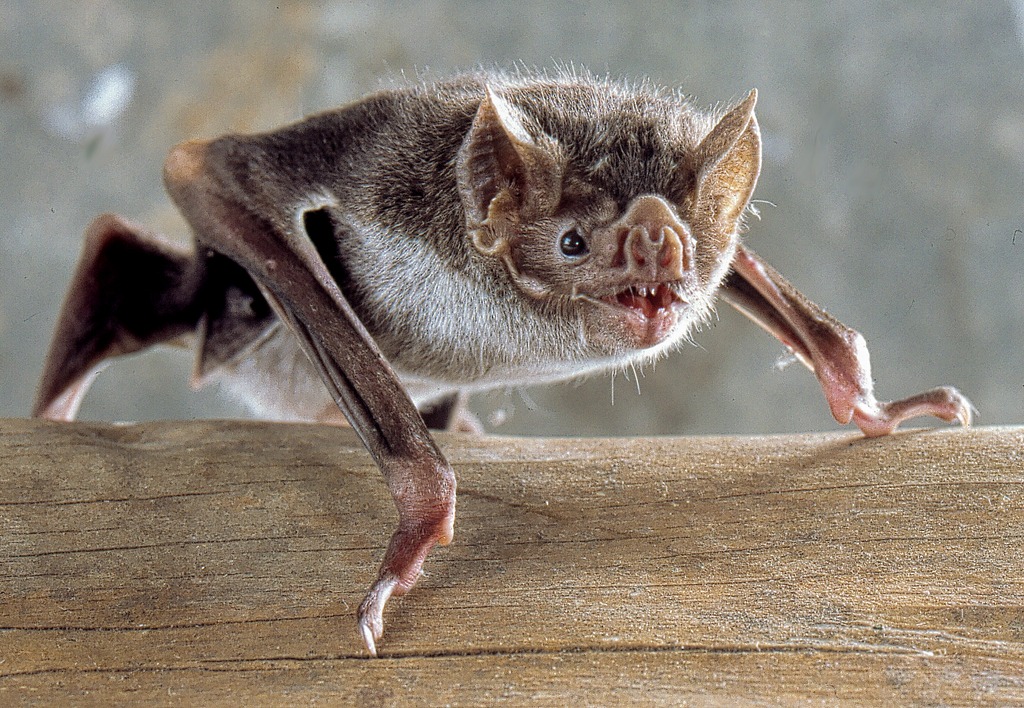 © Wikimedia.org/Uwe Schmidt, CC BY-SA
© Wikimedia.org/Uwe Schmidt, CC BY-SA
The vaquita (/vəˈkiːtə/ və-KEE-tə; Phocoena sinus) is a species of porpoise endemic to the northern end of the Gulf of California in Baja California, Mexico. Averaging 150 cm (4.9 ft) (females) or 140 cm (4.6 ft) (males) in length, it is the smallest of all living cetaceans. The species is currently on the brink of extinction, and currently listed as Critically Endangered by the IUCN Red List; the steep decline in abundance is primarily due to bycatch in gillnets from the illegal totoaba fishery. The smallest living species of cetacean, the vaquita can be easily distinguished from any other species in its range. It has a small body with an unusually tall, triangular dorsal fin, a rounded head, and no distinguished beak. The coloration is mostly grey with a darker back and a white ventral field. Prominent black patches surround its lips and eyes. Sexual dimorphism is apparent in body size, with mature females being longer than males and having larger heads and wider flippers. Females reach a maximum size of about 150 cm (4.9 ft), while males reach about 140 cm (4.6 ft). Dorsal fin height is greater in males than in females. They are also known to weigh around 27 kg (60 lb) to 68 kg (150 lb). This makes them one of the smallest species in the porpoise family. (Source: Wikipedia.org, CC BY-SA)
The vervet monkey (Chlorocebus pygerythrus), or simply vervet, is an Old World monkey of the family Cercopithecidae native to Africa. The term 'vervet' is also used to refer to all the members of the genus Chlorocebus. The five distinct subspecies can be found mostly throughout Southern Africa, as well as some of the eastern countries. Vervets were introduced to Florida, St. Kitts and Nevis, Barbados, and Cape Verde. These mostly herbivorous monkeys have black faces and grey body hair color, ranging in body length from about 40 cm (16 in) for females, to about 50 cm (20 in) for males. In addition to behavioral research on natural populations, vervet monkeys serve as a nonhuman primate model for understanding genetic and social behaviors of humans. They have been noted for having human-like characteristics, such as hypertension, anxiety, and social and dependent alcohol use. Vervets live in social groups ranging from 10 to 70 individuals, with males moving to other groups at the time of sexual maturity. Studies done on vervet monkeys involve their communication and alarm calls, specifically in regard to kin and group recognition, and particular predator sightings. (Source: Wikipedia.org, CC BY-SA)
The vicuña (Lama vicugna) or vicuna (both /vɪˈkuːnjə/, very rarely spelled vicugna, its former genus name) is one of the two wild South American camelids, which live in the high alpine areas of the Andes, the other being the guanaco, which lives at lower elevations. Vicuñas are relatives of the llama, and are now believed to be the wild ancestor of domesticated alpacas, which are raised for their coats. Vicuñas produce small amounts of extremely fine wool, which is very expensive because the animal can only be shorn every three years and has to be caught from the wild. When knitted together, the product of the vicuña's wool is very soft and warm. The Inca valued vicuñas highly for their wool, and it was against the law for anyone but royalty to wear vicuña garments; today, the vicuña is the national animal of Peru and appears on the Peruvian coat of arms. The vicuña is considered more delicate and gracile than the guanaco, and smaller. A key distinguishing element of morphology is the better-developed incisor roots for the guanaco. The vicuña's long, woolly coat is tawny brown on the back, whereas the hair on the throat and chest is white and quite long. The head is slightly shorter than the guanaco's and the ears are slightly longer. The length of head and body ranges from 1.45 to 1.60 m (about 5 ft); shoulder height is from 75 to 85 cm (around 3 ft); its weight is from 35 to 65 kg (under 150 lb). It falls prey to the puma and culpeo. (Source: Wikipedia.org, CC BY-SA)
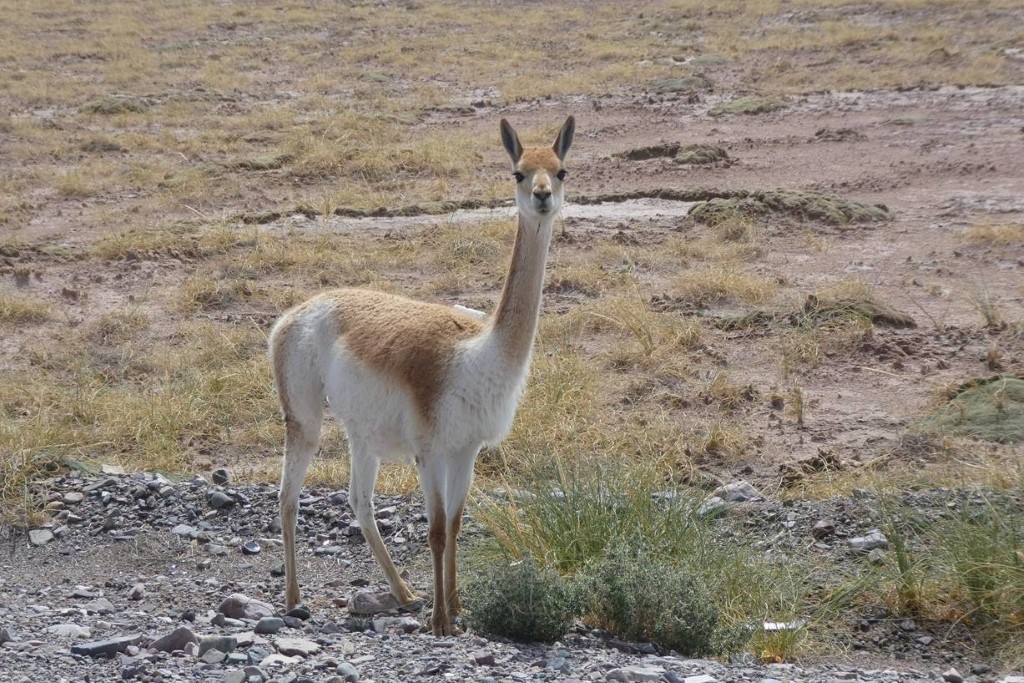 © Wikimedia.org/Papermaker, CC BY-SA
© Wikimedia.org/Papermaker, CC BY-SA
A wallaby (/ˈwɒləbi/) is a small or middle-sized macropod native to Australia and New Guinea, with introduced populations in New Zealand, Hawaii, the United Kingdom and other countries. They belong to the same taxonomic family as kangaroos and sometimes the same genus, but kangaroos are specifically categorised into the four largest species of the family. The term 'wallaby' is an informal designation generally used for any macropod that is smaller than a kangaroo or a wallaroo that has not been designated otherwise. Although members of most wallaby species are small, some can grow up to approximately two metres in length (from the head to the end of the tail). Their powerful hind legs are not only used for bounding at high speeds and jumping great heights, but also to administer vigorous kicks to fend off potential predators. The tammar wallaby (Notamacropus eugenii) has elastic storage in the ankle extensor tendons, without which the animal's metabolic rate might be 30–50% greater. It has also been found that the design of spring-like tendon energy savings and economical muscle force generation is key for the two distal muscle–tendon units of the tammar wallaby (Macropus-Eugenii). Wallabies also have a powerful tail that is used mostly for balance and support. (Source: Wikipedia.org, CC BY-SA)
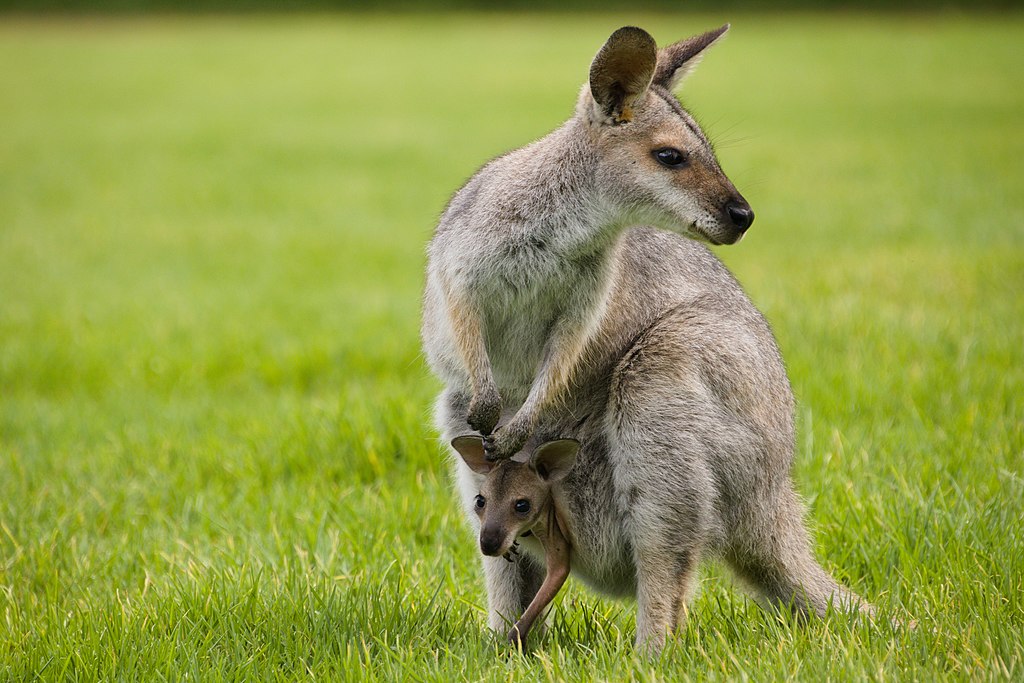 © Wikimedia.org/Caterpillar100, CC BY-SA
© Wikimedia.org/Caterpillar100, CC BY-SA
The walrus (Odobenus rosmarus) is a large flippered marine mammal with a discontinuous distribution about the North Pole in the Arctic Ocean and subarctic seas of the Northern Hemisphere. The walrus is the only living species in the family Odobenidae and genus Odobenus. This species is subdivided into two subspecies: the Atlantic walrus (O. r. rosmarus), which lives in the Atlantic Ocean, and the Pacific walrus (O. r. divergens), which lives in the Pacific Ocean. Adult walrus are characterised by prominent tusks and whiskers, and their considerable bulk: adult males in the Pacific can weigh more than 2,000 kilograms (4,400 pounds) and, among pinnipeds, are exceeded in size only by the two species of elephant seals. Walruses live mostly in shallow waters above the continental shelves, spending significant amounts of their lives on the sea ice looking for benthic bivalve mollusks to eat. Walruses are relatively long-lived, social animals, and they are considered to be a 'keystone species' in the Arctic marine regions. (Source: Wikipedia.org, CC BY-SA)
Phacochoerus is a genus in the family Suidae, commonly known as warthogs (pronounced wart-hog). They are pigs who live in open and semi-open habitats, even in quite arid regions, in sub-Saharan Africa. The two species were formerly considered conspecific under the scientific name Phacochoerus aethiopicus, but today this is limited to the desert warthog, while the best-known and most widespread species, the common warthog (or simply warthog), is Phacochoerus africanus. Although covered in bristly hairs, their bodies and heads appear largely naked from a distance, with only the crest along the back, and the tufts on their cheeks and tails being obviously haired. The English name refers to their facial wattles, which are particularly distinct in males. They also have very distinct tusks, which reach a length of 10 to 25 inches (25 to 64 centimetres) in the males, but are always smaller in the females. They are largely herbivorous, but occasionally also eat small animals. While both species remain fairly common and widespread, and therefore are considered to be of Least Concern by the IUCN, the nominate subspecies of the desert warthog, commonly known as the Cape warthog, became extinct around 1865. (Source: Wikipedia.org, CC BY-SA)
The European water vole or northern water vole (Arvicola amphibius), is a semi-aquatic rodent. It is often informally called the water rat, though it only superficially resembles a true rat. Water voles have rounder noses than rats, deep brown fur, chubby faces and short fuzzy ears; unlike rats their tails, paws and ears are covered with hair. In the wild, on average, water voles only live about five months. Maximum longevity in captivity is two and a half years. Water voles reach 14–22 centimetres (5.5–8.7 in) in length, plus a tail which is about half the length of the body. Weights reported for adults are variable. It is possible for large, optimal adults to weigh as much as 225 to 386 g (7.9 to 13.6 oz) However, these are peak weights. Elsewhere, the mean body mass has been reported as 60 to 140 g (2.1 to 4.9 oz), although this figure includes immature water voles. The minimum weight to successfully breed as well as to survive winter is reportedly 112 g (4.0 oz) in females and 115 g (4.1 oz) in males. As a species the mean body mass is claimed as 140 g (4.9 oz). Overall, European water voles are a uniform dark brown colour, with slightly paler coloration on the underside. Their pelage is quite thick and they are furred over their entire body, including their tail, unlike rats. Their dark colour allows them to blend in well in the densely vegetated areas they inhabit. (Source: Wikipedia.org, CC BY-SA)
The water buffalo (Bubalus bubalis), also called the domestic water buffalo or Asian water buffalo, is a large bovid originating in the Indian subcontinent and Southeast Asia. Today, it is also found in Europe, Australia, North America, South America and some African countries. Two extant types of water buffalo are recognized, based on morphological and behavioural criteria: the river buffalo of the Indian subcontinent and further west to the Balkans, Egypt and Italy and the swamp buffalo, found from Assam in the west through Southeast Asia to the Yangtze valley of China in the east. The skin of the river buffalo is black, but some specimens may have dark, slate-coloured skin. Swamp buffaloes have a grey skin at birth, which becomes slate blue later. Albinoids are present in some populations. River buffaloes have longer faces, smaller girths, and bigger limbs than swamp buffaloes. Their dorsal ridges extend further back and taper off more gradually. Their horns grow downward and backward, then curve upward in a spiral. Swamp buffaloes are heavy-bodied and stockily built; the body is short and the belly large. The forehead is flat, the eyes prominent, the face short, and the muzzle wide. The neck is comparatively long, and the withers and croup are prominent. A dorsal ridge extends backward and ends abruptly just before the end of the chest. Their horns grow outward, and curve in a semicircle, but always remain more or less on the plane of the forehead. The tail is short, reaching only to the hocks. Body the size and shape of horns may vary greatly among breeds. Height at the withers is 129–133 cm (51–52 in) for bulls, and 120–127 cm (47–50 in) for cows, but large individuals may attain 160 cm (63 in). Head-lump length at maturity typically ranges from 240–300 cm (94–118 in) with a 60–100 cm (24–39 in) long tail. They range in weight from 300–550 kg (660–1,210 lb), but weights of over 1,000 kg (2,200 lb) have also been observed. (Source: Wikipedia.org, CC BY-SA)
Weasels /ˈwiːzəlz/ are mammals of the genus Mustela of the family Mustelidae. The genus Mustela includes the least weasels, polecats, stoats, ferrets and European mink. Members of this genus are small, active predators, with long and slender bodies and short legs. The family Mustelidae, or mustelids (which also includes badgers, otters, and wolverines), is often referred to as the 'weasel family'. In the UK, the term 'weasel' usually refers to the smallest species, the least weasel (M. nivalis), the smallest carnivoran species. Least weasels vary in length from 173 to 217 mm (6+3⁄4 to 8+1⁄2 in), females being smaller than the males, and usually have red or brown upper coats and white bellies; some populations of some species moult to a wholly white coat in winter. They have long, slender bodies, which enable them to follow their prey into burrows. Their tails may be from 34 to 52 mm (1+1⁄4 to 2 in) long. (Source: Wikipedia.org, CC BY-SA)
The western gorilla (Gorilla gorilla) is a great ape found in Africa, one of two species of the hominid genus Gorilla. Large and robust with males weighing around 168 kilograms (370 lb), the hair is significantly lighter in color than the eastern gorilla, Gorilla beringei, and geographically isolated from them in a region at the midwest of the African continent. Two subspecies are recognised, Gorilla gorilla diehli (Cross River gorilla) is limited to a smaller range in the north at the border of Cameroon and Nigeria, both are listed Critically Endangered. - (Source: Wikipedia.org, CC BY-SA)
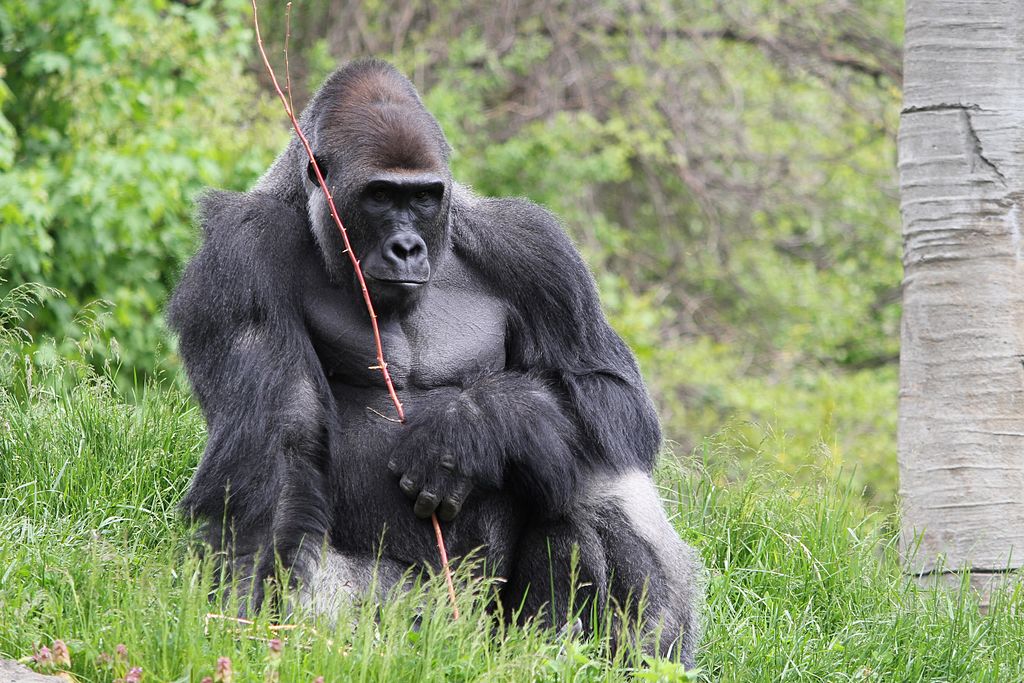 © Wikimedia.org/RedGazelle15, CC BY-SA
© Wikimedia.org/RedGazelle15, CC BY-SA
The western lowland gorilla (Gorilla gorilla gorilla) is one of two Critically Endangered subspecies of the western gorilla (Gorilla gorilla) that lives in montane, primary and secondary forest and lowland swampland in central Africa in Angola, Cameroon, Central African Republic, Republic of the Congo, Democratic Republic of the Congo, Equatorial Guinea and Gabon. It is the nominate subspecies of the western gorilla, and the smallest of the four gorilla subspecies. The western lowland gorilla is the smallest subspecies of gorilla but still has exceptional size and strength. This species of gorillas exhibits pronounced sexual dimorphism. They possess no tails and have jet black skin along with coarse black hair that covers their entire body except for the face, ears, hands and feet. The hair on the back and rump of males takes on a grey coloration and is also lost as they get older. This coloration is the reason why older males are known as 'silverbacks'. Their hands are proportionately large with nails on all digits (similar to those of humans) and very large thumbs. They have short muzzles, prominent brow ridges, large nostrils and small eyes and ears. Other features are large muscles in the jaw region along with broad and strong teeth. Among these teeth are strong sets of frontal canines and large molars in the back of the mouth for grinding fruits and vegetables. (Source: Wikipedia.org, CC BY-SA)
Whales are a widely distributed and diverse group of fully aquatic placental marine mammals. As an informal and colloquial grouping, they correspond to large members of the infraorder Cetacea, i.e. all cetaceans apart from dolphins and porpoises. Dolphins and porpoises may be considered whales from a formal, cladistic perspective. Whales, dolphins and porpoises belong to the order Cetartiodactyla, which consists of even-toed ungulates. Their closest non-cetacean living relatives are the hippopotamuses, from which they and other cetaceans diverged about 54 million years ago. The two parvorders of whales, baleen whales (Mysticeti) and toothed whales (Odontoceti), are thought to have had their last common ancestor around 34 million years ago. Mysticetes include four extant (living) families: Balaenopteridae (the rorquals), Balaenidae (right whales), Cetotheriidae (the pygmy right whale), and Eschrichtiidae (the grey whale). Odontocetes include the Monodontidae (belugas and narwhals), Physeteridae (the sperm whale), Kogiidae (the dwarf and pygmy sperm whale), and Ziphiidae (the beaked whales), as well as the six families of dolphins and porpoises which are not considered whales in the informal sense. Whales are fully aquatic, open-ocean creatures: they can feed, mate, give birth, suckle and raise their young at sea. Whales range in size from the 2.6 metres (8.5 ft) and 135 kilograms (298 lb) dwarf sperm whale to the 29.9 metres (98 ft) and 190 metric tons (210 short tons) blue whale, which is the largest known animal that has ever lived. The sperm whale is the largest toothed predator on Earth. Several whale species exhibit sexual dimorphism, in that the females are larger than males. (Source: Wikipedia.org, CC BY-SA)
The white rhinoceros, white rhino or square-lipped rhinoceros (Ceratotherium simum) is the largest extant species of rhinoceros. It has a wide mouth used for grazing and is the most social of all rhino species. The white rhinoceros consists of two subspecies: the southern white rhinoceros, with an estimated 19,682–21,077 wild-living animals in the year 2015, and the much rarer northern white rhinoceros. The northern subspecies has very few remaining individuals, with only two confirmed left in 2018 (two females: Fatu, 18 and Najin, 29), both in captivity. Sudan, the world's last known male Northern white rhinoceros, died in Kenya on 19 March 2018 at age 45. The white rhinoceros is the largest of the five living species of rhinoceros. By mean body mass, the white rhinoceros falls behind only the three extant species of elephant as the largest land animal and terrestrial mammal alive today. It weighs slightly more on average than a hippopotamus despite a considerable mass overlap between these two species. It has a massive body and large head, a short neck and broad chest. (Source: Wikipedia.org, CC BY-SA)
The Panamanian white-faced capuchin (Cebus imitator), also known as the Panamanian white-headed capuchin or Central American white-faced capuchin, is a medium-sized New World monkey of the family Cebidae, subfamily Cebinae. Native to the forests of Central America, the white-faced capuchin is important to rainforest ecology for its role in dispersing seeds and pollen. Among the best known monkeys, the Panamanian white-faced capuchin is recognized as the typical companion to the organ grinder. In recent years the species has become popular in American media, particularly in the Pirates of the Caribbean film series. It is a highly intelligent monkey and has been trained to assist paraplegic persons. It is a medium-sized monkey, weighing up to 3.9 kg (8 lb 10 oz). It is mostly black, but with a pink face and white on much of the front part of the body, giving it its common name. It has a distinctive prehensile tail that is often carried coiled up and is used to help support the monkey when it is feeding beneath a branch. (Source: Wikipedia.org, CC BY-SA)
The wild boar (Sus scrofa), also known as the wild swine, common wild pig, Eurasian wild pig, or simply wild pig, is a suid native to much of Eurasia and North Africa, and has been introduced to the Americas and Oceania. The species is now one of the widest-ranging mammals in the world, as well as the most widespread suiform. It has been assessed as least concern on the IUCN Red List due to its wide range, high numbers, and adaptability to a diversity of habitats. It has become an invasive species in part of its introduced range. Wild boars probably originated in Southeast Asia during the Early Pleistocene and outcompeted other suid species as they spread throughout the Old World. The wild boar is a bulky, massively built suid with short and relatively thin legs. The trunk is short and robust, while the hindquarters are comparatively underdeveloped. The region behind the shoulder blades rises into a hump and the neck is short and thick to the point of being nearly immobile. The animal's head is very large, taking up to one-third of the body's entire length. The structure of the head is well suited for digging. The head acts as a plough, while the powerful neck muscles allow the animal to upturn considerable amounts of soil: it is capable of digging 8–10 cm (3.1–3.9 in) into frozen ground and can upturn rocks weighing 40–50 kg (88–110 lb). The eyes are small and deep-set and the ears long and broad. The species has well developed canine teeth, which protrude from the mouths of adult males. The medial hooves are larger and more elongated than the lateral ones and are capable of quick movements. The animal can run at a maximum speed of 40 km/h (25 mph) and jump at a height of 140–150 cm (55–59 in). (Source: Wikipedia.org, CC BY-SA)
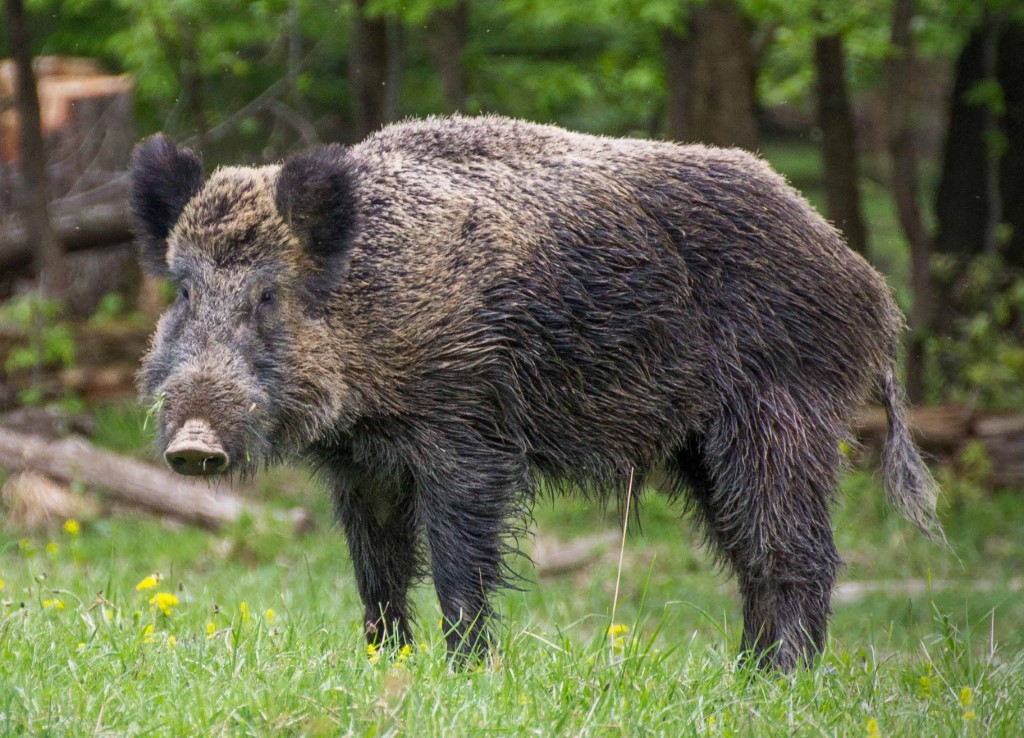 © Wikimedia.org/Valentin Panzirsch, CC BY-SA-AT
© Wikimedia.org/Valentin Panzirsch, CC BY-SA-AT
The wolf (Canis lupus; pl: wolves), also known as the gray wolf or grey wolf, is a large canine native to Eurasia and North America. More than thirty subspecies of Canis lupus have been recognized, and gray wolves, as popularly understood, comprise wild subspecies. The wolf is the largest extant member of the family Canidae. It is also distinguished from other Canis species by its less pointed ears and muzzle, as well as a shorter torso and a longer tail. The wolf is nonetheless related closely enough to smaller Canis species, such as the coyote and the golden jackal, to produce fertile hybrids with them. The banded fur of a wolf is usually mottled white, brown, gray, and black, although subspecies in the arctic region may be nearly all white. Like all land mammals that are pack hunters, the wolf feeds predominantly on wild herbivorous hoofed mammals that can be divided into large size 240–650 kg (530–1,430 lb) and medium size 23–130 kg (51–287 lb), and have a body mass similar to that of the combined mass of the pack members. The wolf specializes in preying on the vulnerable individuals of large prey, with a pack of 15 able to bring down an adult moose. The variation in diet between wolves living on different continents is based on the variety of hoofed mammals and of available smaller and domesticated prey. (Source: Wikipedia.org, CC BY-SA)
The wolverine (/ˈwʊlvəriːn/), (Gulo gulo; Gulo is Latin for 'glutton'), also referred to as the glutton, carcajou, or quickhatch (from East Cree, kwiihkwahaacheew), is the largest land-dwelling species of the family Mustelidae. It is a muscular carnivore and a solitary animal. The wolverine has a reputation for ferocity and strength out of proportion to its size, with the documented ability to kill prey many times larger than itself. The adult wolverine is about the size of a medium dog, with a body length ranging from 65–113 cm (26–44 in); standing 36–45 cm (14–18 in) at the shoulder; and a tail length of 17–26 cm (6+1⁄2–10 in). Males range in weight from 11–27.5 kg (24–61 lb), and females 7–19 kg (15–42 lb). Exceptionally large males of as much as 32 kg (71 lb) are referenced in Russian literature, though such weights are deemed in Mammals of the Soviet Union to be improbable. The males are often 10–15% larger than the females in linear measurements and can be 30–40% greater in weight. According to some sources, Eurasian wolverines are claimed to be larger and heavier than North American, with average weights in excess of 20 kg (44 lb). (Source: Wikipedia.org, CC BY-SA)
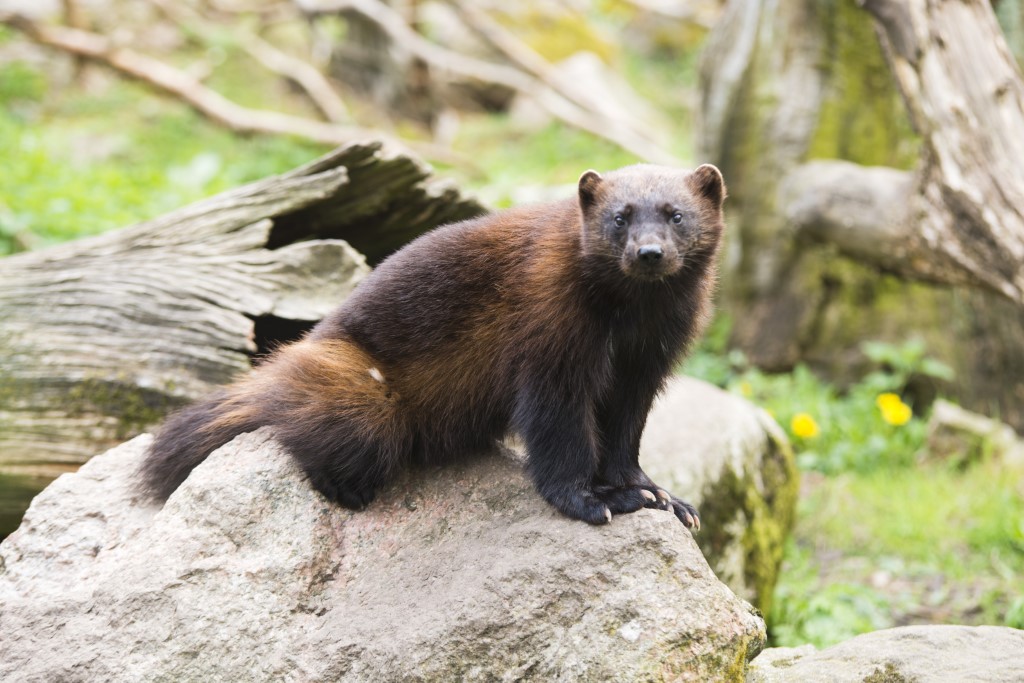 © Wikimedia.org/Jonathan Othén, CC BY-SA
© Wikimedia.org/Jonathan Othén, CC BY-SA
Wombats are short-legged, muscular quadrupedal marsupials that are native to Australia. They are about 1 m (40 in) in length with small, stubby tails and weigh between 20 and 35 kg (44 and 77 lb). All three of the extant species are members of the family Vombatidae. They are adaptable and habitat tolerant, and are found in forested, mountainous, and heathland areas of southern and eastern Australia, including Tasmania, as well as an isolated patch of about 300 ha (740 acres) in Epping Forest National Park in central Queensland. Wombats dig extensive burrow systems with their rodent-like front teeth and powerful claws. One distinctive adaptation of wombats is their backward pouch. The advantage of a backward-facing pouch is that when digging, the wombat does not gather soil in its pouch over its young. Although mainly crepuscular and nocturnal, wombats may also venture out to feed on cool or overcast days. They are not commonly seen, but leave ample evidence of their passage, treating fences as minor inconveniences to be gone through or under. (Source: Wikipedia.org, CC BY-SA)
The Wombats are the genus Lagothrix of New World monkeys, usually placed in the family Atelidae. Both species in this genus originate from the rainforests of South America. They have prehensile tails and live in relatively large social groups. Woolly monkeys are closely related to spider monkeys. They have a thick brown coat with dark gray appendages. The stomach area is black and heads are light brown. The fur color is the same for both males and females. Variation in color exist among subspecies. A prehensile tail assists in climbing and fulfills many functions of an opposable thumb. Arm and legs are about equal in length. All species are large, weighing around 7 kilograms (15 lb). Males weigh 45% more than females on average but are of equal length. (Source: Wikipedia.org, CC BY-SA)
The wild yak (Bos mutus) is a large, wild bovine native to the Himalayas. It is the ancestor of the domestic yak (Bos grunniens). The wild yak is among the largest extant bovid species. Adults stand about 1.6 to 2.05 m (5.2 to 6.7 ft) tall at the shoulder, and weigh 500–1,200 kg (1,100–2,600 lb). The head and body length is 2.4 to 3.8 m (7.9 to 12 ft), not counting the tail of 60 to 100 cm (24 to 39 in). The females are about one-third the weight and are about 30% smaller in their linear dimensions when compared to bull wild yaks. Domesticated yaks are somewhat smaller. They are heavily built animals with a bulky frame, sturdy legs, and rounded cloven hooves. To protect against the cold, the udder in females and the scrotum in males are small, and covered in a layer of hair. Females have four teats. Both sexes have long shaggy hair, with a dense woolly undercoat over the chest, flanks, and thighs for insulation against the cold. In males especially, this undercoat may form a long 'skirt' that can reach the ground. The tail is long and horse-like, rather than tufted like the tails of cattle or bison. The coat is typically black or dark brown, covering most of the body, with a grey muzzle (although some wild golden-brown individuals have been reported). Wild yaks with gold coloured hair are known as the wild golden yak (Chinese: 金色野牦牛; pinyin: jīnsèyě máoniú). They are considered an endangered subspecies in China, with an estimated population of 170 left in the wild. (Source: Wikipedia.org, CC BY-SA)
Zebras (US: /ˈziːbrəz/, UK: /ˈzɛbrəz, ˈziː-/) (subgenus Hippotigris) are African equines with distinctive black-and-white striped coats. There are three living species: the Grévy's zebra (Equus grevyi), plains zebra (E. quagga), and the mountain zebra (E. zebra). Zebras share the genus Equus with horses and asses, the three groups being the only living members of the family Equidae. Zebra stripes come in different patterns, unique to each individual. Several theories have been proposed for the function of these stripes, with most evidence supporting them as a deterrent for biting flies. Zebras inhabit eastern and southern Africa and can be found in a variety of habitats such as savannahs, grasslands, woodlands, shrublands, and mountainous areas. Zebras are primarily grazers and can subsist on lower-quality vegetation. They are preyed on mainly by lions and typically flee when threatened but also bite and kick. Zebra species differ in social behaviour, with plains and mountain zebra living in stable harems consisting of an adult male or stallion, several adult females or mares, and their young or foals; while Grévy's zebra live alone or in loosely associated herds. In harem-holding species, adult females mate only with their harem stallion, while male Grévy's zebras establish territories which attract females and the species is promiscuous. Zebras communicate with various vocalisations, body postures and facial expressions. Social grooming strengthens social bonds in plains and mountain zebras. (Source: Wikipedia.org, CC BY-SA)
The zebu (/ˈziːb(j)uː, ˈzeɪbuː/; Bos indicus or Bos taurus indicus), sometimes known in the plural as indicine cattle or humped cattle, is a species or subspecies of domestic cattle originating in the Indian sub-continent. Zebu are characterised by a fatty hump on their shoulders, a large dewlap, and sometimes drooping ears. They are well adapted to withstanding high temperatures, and are farmed throughout the tropical countries, both as pure zebu and as hybrids with taurine cattle, the other main type of domestic cattle. Zebu are used as draught and riding animals, dairy cattle, and beef cattle, as well as for byproducts such as hides and dung for fuel and manure. Some small breeds such as the miniature zebu are also kept as pets. In 1999, researchers at Texas A&M University successfully cloned a zebu. Zebu have humps on the shoulders, large dewlaps, and droopy ears. Compared to taurine cattle, zebus are well adapted to the hot, dry environment of the tropics. Adaptations include resistance to drought and tolerance of intense heat and sunlight. (Source: Wikipedia.org, CC BY-SA)
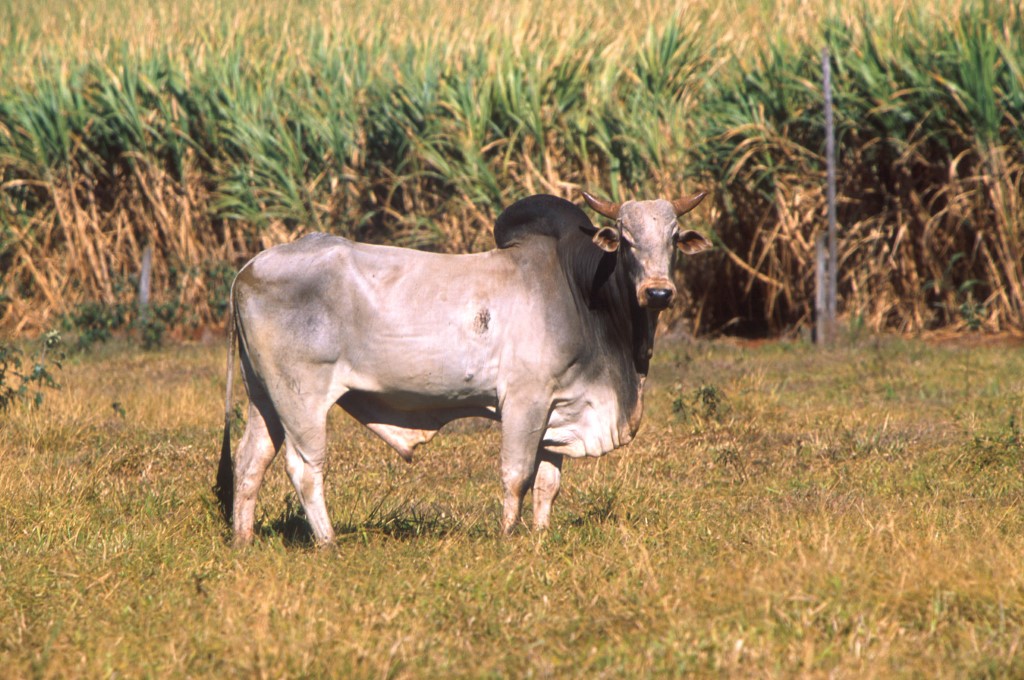 © Wikimedia.org/Scott Bauer>, CC0
© Wikimedia.org/Scott Bauer>, CC0

Time for recess! Post a comment, ask a question or write a review. Feel free to let us know what you think!
Ben fransada turkce deralere girecem ehliyet ici sinavlari bilen bana yardimci olur mu
Mrhaba bu hafta yaziliya girecem bana yardimci olmak isteyen varmi isvec yazilisina cok korkuyorum yalniz
Orda tabela var otoban başlangıçı icin sorular bunlar Otoyolun başlangıçı Park etmek yasaktır Otobanın başlangıcı Giriş yapmak yasaktır Ben otobanın başlangıçı basıyom yok yanlışmiş otoyolun başlangıçıymız tabi biz türkiyede yaşıyoz unutum ben amk
Elinize sağlık Türkiye'de olmayan birçok levha var.Mantık yürüterek dogru cevapları bulmaya çalıştım.
Gercekten emeginize saglık. Alakasız ve yanlıs birsürü testle karşılaştım, sonunda faydalı bir sayfaya denk geldim.
Merhaba benim Türk ehliyetim var Romanya ehliyeti ile değiştirmek istiyorum nasıl yapabilirim
Dun sinava girdim tek bir soruyla kaybettim dogru bildim konturol ettim 3 soruyu yannis ciklarla cevirdim
HAZIRLAYANLARDAN ALLAH RAZI OLSUN IN$LLH COK GÜZEL-TEK SIKINTI COK AZ TÜRKCE CEVIRIMLERDE AMA OLSUN BEN COK BEGENDIM TE$EKKÜRLER
Bazı sorularda yazımı da aynı olan 2 aynı doğru cevap var. Örnek: Yayalar için yolun sonu. Yerleşim alanının sonu. Bir yerleşim alanının başlangıcı. Yerleşim alanının sonu.